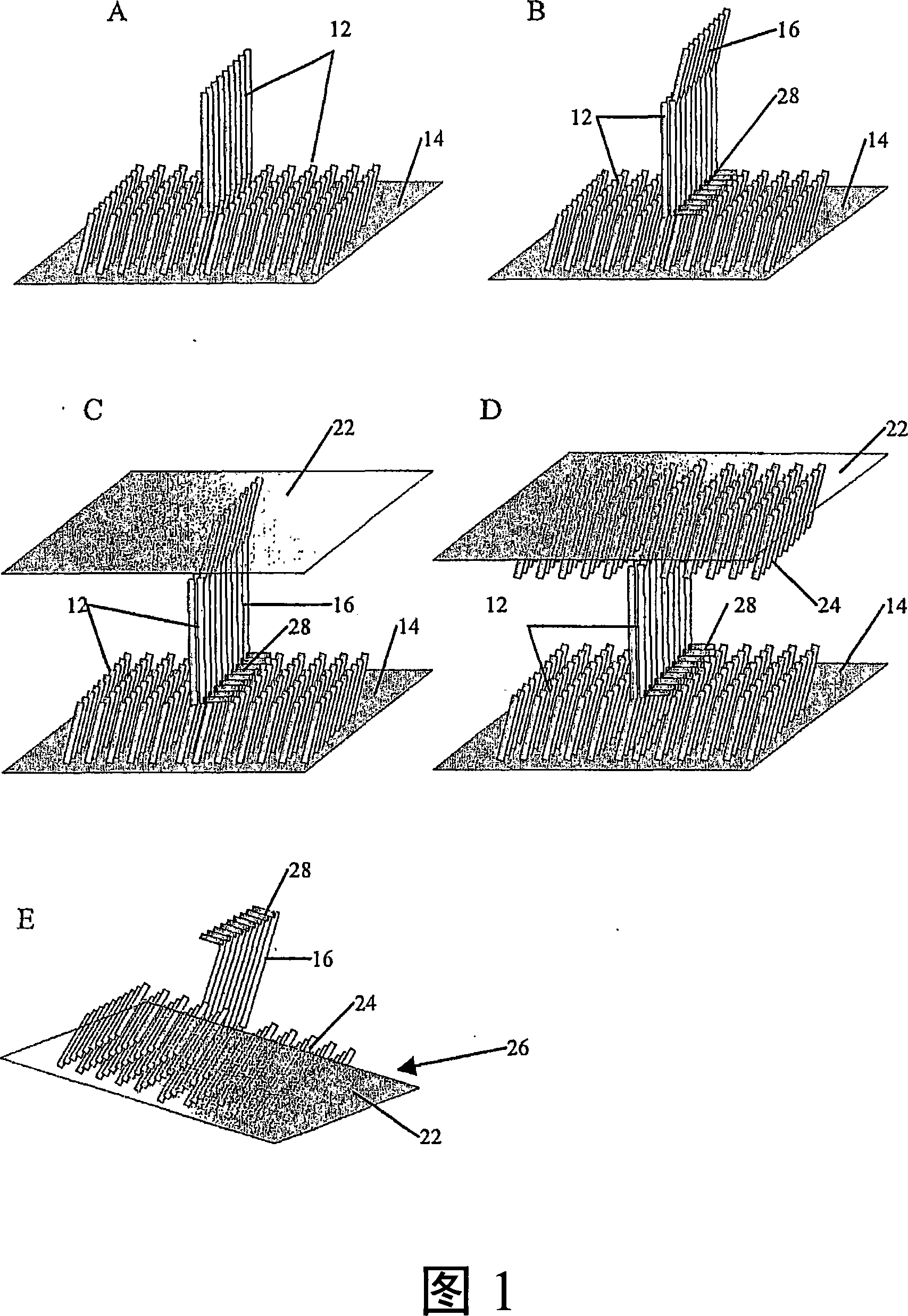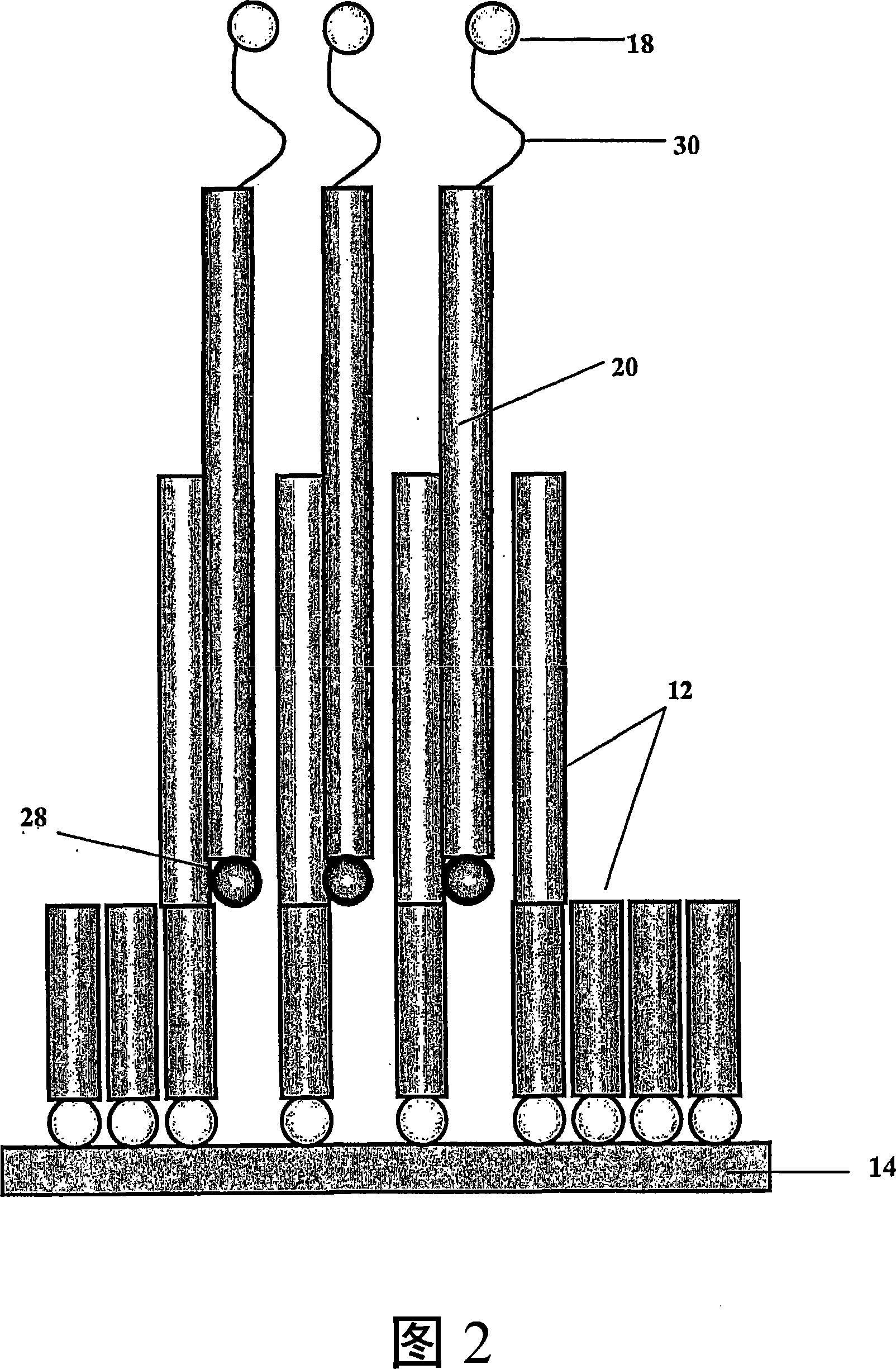Nano contact printing
A surface contact, molecular technology, applied in nanotechnology, nanotechnology, nanotechnology for information processing, etc., can solve problems such as large amount of time, and achieve the effect of repeatability improvement
- Summary
- Abstract
- Description
- Claims
- Application Information
AI Technical Summary
Problems solved by technology
Method used
Image
Examples
Embodiment 1
[0098] Example 1: Preparation of complementary images of DNA monolayers
[0099] a. Preparation of DNA solution
[0100] Before use, wash with 75% H 2 SO 4 and 25% H 2 o 2 solution to clean all glassware. All water used was ultrapure water (18 MΩ / cm).
[0101] The first DNA 5'- / 5-thiol MC6-D / ACG CAA CTT CGG GCT CTT-3' was purchased from Integrated DNA Technologies, Inc. (IDT), Coraville, IA. All DNA strands were used as received from the manufacturer. The primary DNA was dissolved in water at a concentration of 1 μg / mL, divided into smaller aliquots of 50 μL, and stored at -20°C. When using a portion of this solution, it was reduced by placing an aliquot in 40 mM buffer solution (0.17 M sodium phosphate, pH 8) containing dithiothreitol (DTT) for 16 hr. Oligonucleotides and by-products of the DTT reaction were separated using size exclusion chromatography (NAP 10 column from Pharmacia Biotech) according to the manufacturer's instructions. 10 mM sodium phosphate buf...
Embodiment 2
[0110] Example 2: Pattern transfer of gold grid
[0111] AFM calibrated gold grids were soaked for 5 days in a 4 μM solution of the first DNA molecule as described in Example 1 to generate a patterned body. The main body was exposed to 1 mM 6-mercapto-1-hexanol aqueous solution for 2 hr to minimize non-specific adsorption of single-stranded DNA, then rinsed 5 times with water and air-dried. Hybridization occurs by exposing the subject to a 6 μM solution of the second DNA described in Example 1 for 2 hours. The gold on second mica substrate was placed on the body so that the two gold surfaces faced each other with a small amount of water between them. A small mechanical force is applied to push the two substrates together. After about 5 hr, the substrate was soaked in 1M NaCl (70°C) in TE buffer for 20 min. The two substrates (ie, the main body and the complementary image) were automatically separated, rinsed twice with 1 M NaCl in TE buffer and five times with water, and ...
Embodiment 3
[0112] Example 3: Fabrication of DNA chips
[0113] The host was prepared using dip pen nanolithography as described by Demer et al., Angew. Chem. Int. Ed. (2001), 40:307 1-3073, the entire teaching of which is incorporated herein by reference. To prepare the host, the gold surface on the mica substrate was contacted with a 1 mM solution of 1-octadecanethiol (ODT) in ethanol for 5 min to cover the exposed gold surface with ODT molecules. The substrate was then immersed in a 1 mM solution of 1,16-mercaptohexadecanic acid (MHA) and the displacement was bound to the surface using the tip of an atomic force microscope by contacting the surface with a force of about 0.5 nN to create a 100 nm dot. ODT molecules. The MHA in solution binds to the exposed gold surfaces of the dots. Activate MHA with a 10 mg / mL solution of 1-ethyl-3-(3-dimethylaminopropyl)carbodiimide hydrochloride (EDAC) in 0.1 M morpholine / ethanesulfonic acid at pH 4.5 carboxylic acid groups, and then rinsed with...
PUM
 Login to View More
Login to View More Abstract
Description
Claims
Application Information
 Login to View More
Login to View More - Generate Ideas
- Intellectual Property
- Life Sciences
- Materials
- Tech Scout
- Unparalleled Data Quality
- Higher Quality Content
- 60% Fewer Hallucinations
Browse by: Latest US Patents, China's latest patents, Technical Efficacy Thesaurus, Application Domain, Technology Topic, Popular Technical Reports.
© 2025 PatSnap. All rights reserved.Legal|Privacy policy|Modern Slavery Act Transparency Statement|Sitemap|About US| Contact US: help@patsnap.com



